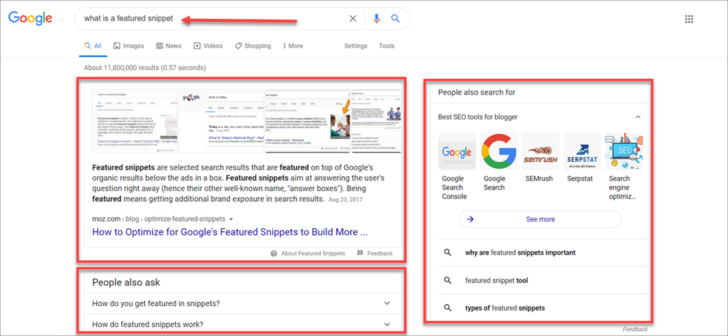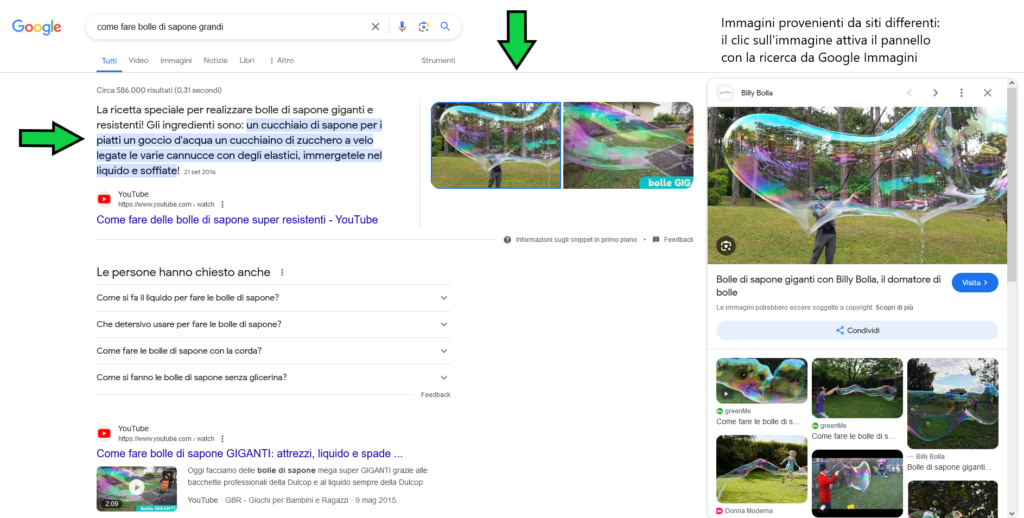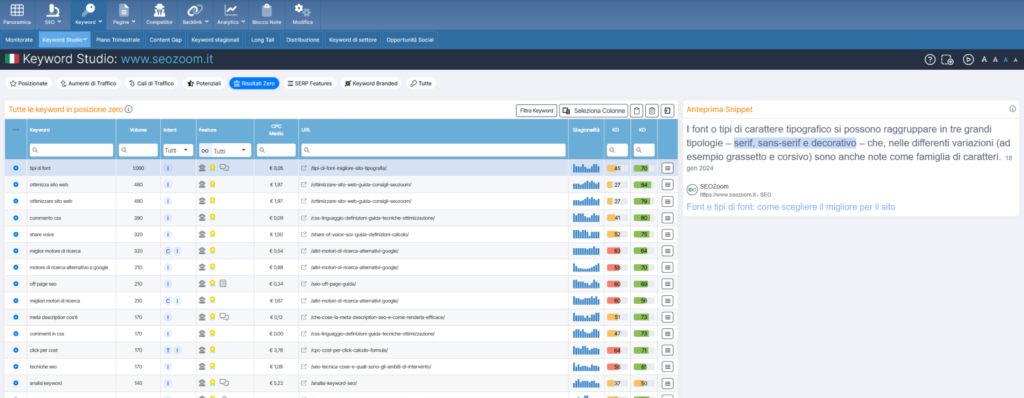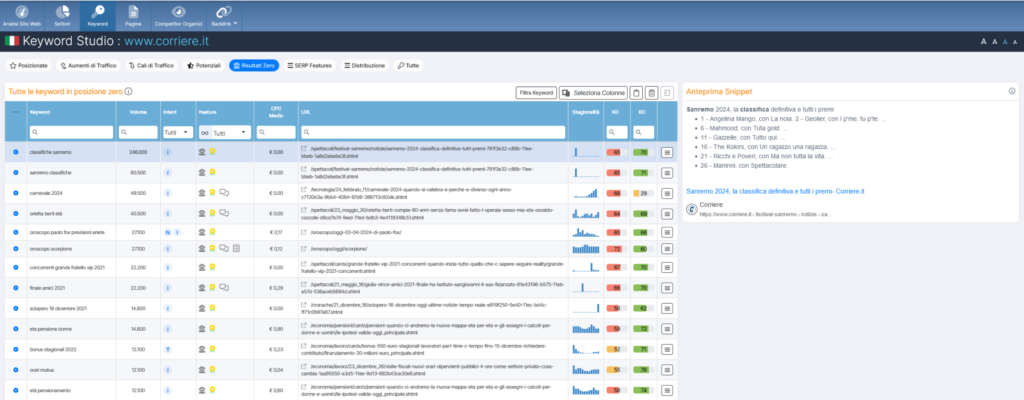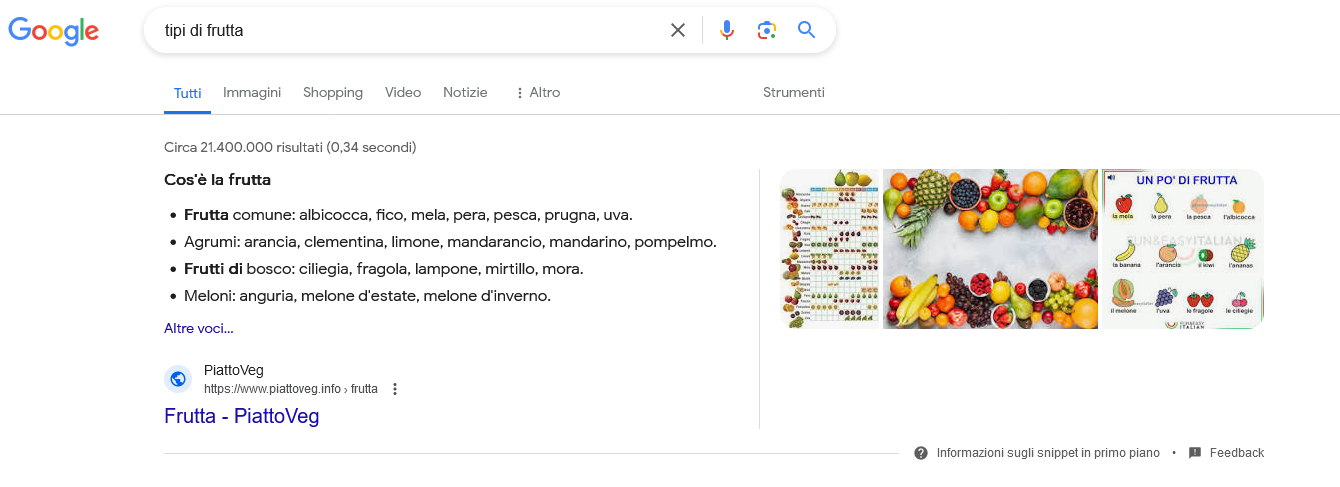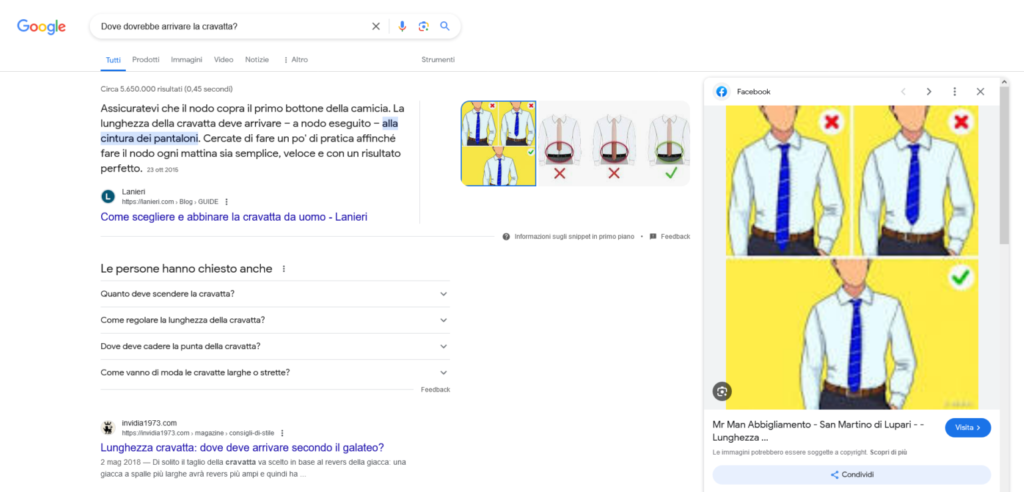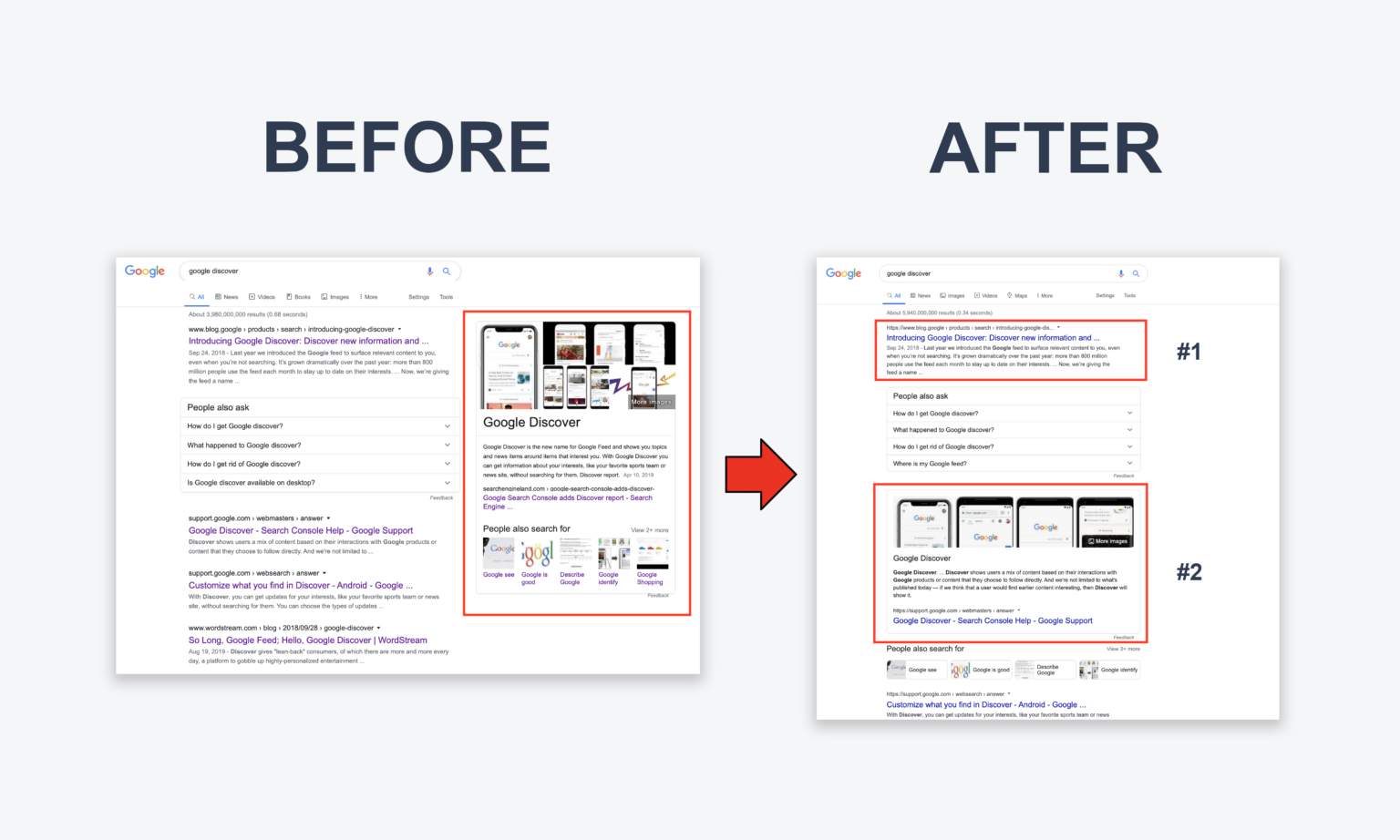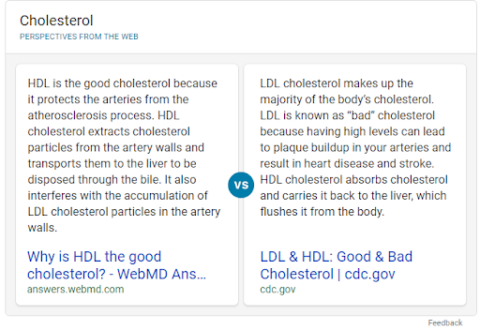Featured Snippet di Google: cosa sono e come si ottengono
Amati e odiati dai SEO specialist, i featured snippet rappresentano quella sezione privilegiata delle SERP dove Google fornisce risposte immediate alle domande degli utenti, e che si distinguono dal resto dei risultati per il design accattivante, che cattura lo sguardo. Espressione concreta dell’evoluzione di Google verso un motore di risposta, i featured snippet sono ancora oggi al centro di un dibattito tra chi appunto li ama apprezzandone i benefici in termini di visibilità e quanti invece ne temono l’impatto negativo sul traffico, perché erodono clic al sito. Esploriamo quindi la natura di questi “ritagli speciali” e le strategie per ottenerli, per conquistare una posizione di rilievo nelle pagine dei risultati di ricerca e aumentare il CTR verso il sito.
Che cosa sono i featured snippet di Google
Un featured snippet è un formato di presentazione dei risultati di ricerca che Google mostra in evidenza in determinate SERP per rispondere direttamente alla query di un utente.
Questo estratto è selezionato automaticamente dal motore di ricerca per fornire una risposta rapida, spesso senza che l’utente debba cliccare su un link. Il contenuto di un featured snippet può essere un paragrafo, un elenco, una tabella o anche un video, ed è elaborato in modo diverso rispetto agli estratti standard, per renderlo più leggibile e immediatamente comprensibile.
Si chiamano featured snippet perché pongono attenzione sullo “snippet”, ovvero sulla descrizione della pagina, invertendo la consueta presentazione usata dai motori di ricerca. Come spiega Google, infatti, normalmente la descrizione di una pagina segue l’elenco dei link in SERP, mentre con i featured snippet l’estratto di contenuto viene messo in risalto rispetto al resto delle informazioni e mostrato per primo.
Questi riquadri compaiono letteralmente al di sopra dei risultati organici tradizionali, in una posizione privilegiata che ha generato il nome di “Posizione zero” che usiamo anche in SEOZoom. I featured snippet sono noti anche con le espressioni snippet in primo piano o snippet in evidenza, che parimenti fanno riferimento alle loro caratteristiche principali, che li distinguono anche dai classici snippet di Google, ovvero i ritagli rappresentati da meta description, titolo e URL.
A cosa servono i featured snippet
Google ha iniziato a introdurre i featured snippet nel 2014: sin da allora, il loro scopo è quello di rispondere immediatamente all’interrogativo dell’utente, estraendo e mostrando un frammento di contenuto direttamente dalla pagina web che Google ritiene più pertinente. Questo estratto è accompagnato dal titolo della pagina, dall’URL e, talvolta, da un’immagine.
Google li utilizza per fornire risposte rapide e dirette, migliorando l’esperienza dell’utente e, al contempo, offrendo ai siti web l’opportunità di spiccare tra i risultati di ricerca.
Google chiarisce che gli snippet in primo piano provengono sempre da risultati già indicizzati della ricerca web e che la gestione della scelta della pagina e della porzione di contenuto è del tutto automatica e dipende dagli algoritmi del motore di ricerca, che determinano appunto cosa costituisca un valido snippet in primo piano da mettere in evidenza per una richiesta di ricerca specifica.
Oggi gli snippet si possono trovare prima dei risultati di ricerca complessivi, in altre aree della pagina dei risultati, all’interno della sezione “Le persone hanno chiesto anche” o insieme alle informazioni del Knowledge Graph e, dal punto di vista del motore di ricerca, servono a migliorare la user experience, perché gli utenti ottengono le informazioni di cui hanno bisogno senza mai dover visitare effettivamente un sito web.
I featured snippet sono stati uno dei più forti segnali dell’evoluzione del motore di ricerca, che ha iniziato a concentrare attenzione anche a chi naviga da mobile. In origine, la classica pagina dei risultati di Google era composta da 10 link blu che rimandavano ad altrettante risorse che gli algoritmi del motore di ricerca più famoso e utilizzato al mondo avevano ritenuto valide e affidabili, ognuno dei quali presentato con una piccola anteprima, il cosiddetto snippet che fornisce una rapida sintesi del titolo e del contenuto che ci avrebbe atteso sulla pagina.
Da diversi anni questo schema non è più valido e le SERP di Google sono sempre mutevoli: non solo possono comparire elementi aggiuntivi alla ricerca (da un’anteprima delle immagini ai video, da un box di notizie in primo piano a ricerche correlate al knowledge graph, con contenuti sintetici e riepilogativi, risposte, widget o altri dati ancora), ma appunto anche questi “risultati zero” in evidenza e in precedenza rispetto agli altri link, che si issano prima della “posizione uno” ed emergono in modo indipendente dal posizionamento dei vari siti all’interno delle SERP, di cui non modificano l’ordine.
E non è neppure l’ultimo livello dell’evoluzione, perché con la prossima introduzione di Search Generative Experience – il potenziamento del motore di ricerca via Intelligenza Artificiale, che ha già debuttato negli Stati Uniti ed è atteso ancora in Europa – la situazione potrebbe cambiare ulteriormente. Nei primi test, infatti, le risposte di SGE somigliavano a un “super” featured snippet, ancora più carico di informazioni e di elementi che trattengono nella SERP l’utente, che inizia e completa il suo viaggio sempre (e solo?) su Google.
Cos’è la posizione zero di Google e come si compone
In estrema sintesi, i featured snippet sono dei box che, in forme diverse, compaiono per molte ricerche su Google, fornendo una risposta precisa e diretta alle domande degli utenti direttamente in SERP, senza che loro abbiano necessità di fare clic su un risultato specifico per ottenere le informazioni desiderate.
Nelle immagini qui sotto, la freccia indica visivamente qual è il featured snippet, chiaramente più ampio e dettagliato dei classici snippet: generalmente questo spazio si colloca in cima a tutti i posizionamenti della prima pagina di Google, e rappresentano il modo in cui il motore di ricerca offre una prima, sintetica ma esaustiva, risposta alla query dell’utente, provando a intercettare e risolvere rapidamente il suo search intent.
Inoltre, Google utilizza i featured snippet anche per offrire risultati aggiornati su un tema in evoluzione, come avvenuto in occasione del caso del cielo arancione in California, e assicurare quindi la validità dell’algoritmo QDF delle SERP offrendo risultati freschi.
Inizialmente, i box si presentavano con un design meno elaborato, all’interno di un’area ben delimitata e con un’ombreggiatura che li distingueva dai risultati organici classici. Attualmente invece sono diventati molto più articolati (e spesso invasivi), così da conquistare ancora di più l’attenzione del lettore.
Nella sua forma classica, un featured snippet si compone in questo modo:
- Un testo estratto da un sito, con grassetti che evidenziano alcune parole.
- Un titolo.
- L’URL della pagina da cui è stato preso il testo.
- Un’immagine che amplia il contenuto informativo (l’immagine può anche non appartenere allo stesso URL e in genere rimanda alla pagina di ricerca di Google Immagini per la relativa query).
Un’altra funzione utile introdotta da alcuni anni in via definitiva riguarda l’evidenziazione e l’ancoraggio del testo onpage di cui Google si è servito per creare lo snippet. L’utente che in SERP clicca sul link blu nel box, infatti, atterra direttamente sulla parte di pagina del sito in cui è presente quel riferimento, e potenzialmente potrebbe non vedere tutto il contenuto della pagina stessa, soffermandosi soltanto sul paragrafo a cui era interessato.
La definizione di featured snippet per Google
Usando le parole di Google, “quando riconosciamo che una query è una domanda, individuiamo in modo programmatico le pagine che contengono la risposta e mostriamo il risultato più pertinente in uno snippet in primo piano nei risultati di ricerca”.
Pertanto, come sottolinea la guida di Search Central, il risultato in posizione zero, o featured snippet, è essenzialmente un box o di un riquadro speciale che contiene la risposta che Google “reputa più precisa in riferimento alla domanda posta da un utente in Ricerca Google”.
In pratica, l’algoritmo del motore di ricerca offre immediatamente la risposta al search intent, mostrandola “in un riquadro speciale di snippet in primo piano nella parte superiore della pagina dei risultati di ricerca”, segnalando in maniera chiara che si tratta di un contenuto fornito dal Web, con rimando link alla pagina, titolo e URL ben visibili.
Insomma, il featured snippet è un box con cui Google offre una risposta a una query di intento informazionale (espressa con o senza pronomi e avverbi interrogativi, ovvero “chi, che cosa, dove, quando, dove, perché” e così via) o in alcuni casi commerciale (ad esempio per gli approfondimenti sulla qualità di prodotti o servizi, o per comparare due brand o due articoli da acquistare) degli utenti attingendo a risorse esterne, selezionate sulla base di una combinazione di fattori tra cui lunghezza del testo, formattazione, autorevolezza della pagina e utilizzo di protocollo HTTPS.
In poche righe, Google offre all’utente esattamente ciò di cui ha bisogno (o ciò che pensa che lui ricerchi), e difatti il primo effetto dei featured snippet è di rendere superflua la SERP per quella determinata query: nella maggior parte dei casi, la sintesi proposta nel risultato zero risulta sufficiente a soddisfare l’intent della persona, che non deve cliccare su nessun risultato specifico ma eventualmente la sua journey di approfondimento con altre query.
Featured snippet, da dove prende Google le risposte?
Come detto, i risultati zero sono presi da Google da siti terzi, citati in maniera appropriata con link alla fonte: le linee guida di Big G specificano che sono un riepilogo “estratto in modo programmatico da ciò che un utente vede sulla pagina web”, che “riflettono i punti di vista e le opinioni del sito da cui sono estratti” e che il motore di ricerca lavora per migliorare la “capacità di identificare gli snippet più utili, pertanto i risultati mostrati potrebbero cambiare nel tempo”.
Fino al gennaio 2020, i siti con featured snippet avevano anche il link blu nella prima pagina della SERP della query, e ciò quindi rappresentava una doppia opportunità di conquistare il clic degli utenti. Oggi non è più così perché Google ha preferito optare per la deduplicazione dei risultati, e quindi il sito scelto da Google per il box in evidenza non ha più un URL posizionato tra i link organici.
Elemento interessante, prima della deduplicazione la pagina usata per estrarre lo snippet non appariva necessariamente alla posizione numero 1: in molti casi, infatti, lo snippet veniva desunto anche da risultati che originariamente erano in seconda e in terza posizione, o addirittura in quarta (si veda il caso di dorayaki, qui nelle immagini).

I siti preferiti per i featured snippet di Google Italia: i dati di SEOZoom
Dal gennaio 2020, ovviamente, non c’è riscontro empirico sulla posizione originaria della pagina da cui Google estrae il featured snippet, ma con SEOZoom abbiamo avuto modo di estrapolare alcuni dati interessanti circa i risultati zero su Google Italia (dati aggiornati ad aprile 2024).
Analizzando un campione di 10 milioni di keyword, abbiamo innanzitutto scoperto che ad oggi ci sono 2,7 milioni di keyword su Google.it che attivano featured snippet, nella stragrande maggioranza per intenti di tipo informational, anche se non mancano parole chiave commercial. In pratica, una ricerca su quattro in Italia mostra un risultato zero, a riprova di quanto abbiamo rivelato già tempo fa con il nostro studio sull’impatto delle varie feature sulla visibilità dei risultati organici; con keyword afferenti a settori differenti per tipologia e natura: dalle ricette di cucina alle informazioni scientifiche, dalle classifiche di Sanremo fino alle definizioni grammaticali o alle voci enciclopediche, i risultati in evidenza sono in forte aumento, con tendenza previsionale altrettanto positiva.
Sul podio dei siti scelti da Google come fonte ci sono Wikipedia, My-Personaltrainer e Treccani. In dettaglio, la versione italiana di Wikipedia è il sito da cui Google estrae più featured snippet, con oltre 200mila keyword che attivano questo spazio in evidenza, seguito dal portale informativo sulla salute (oltre 70mila occorrenze, soprattutto per key legate a topic legati a salute, alimentazione e stili di vita, con forte autorevolezza nonostante il calo dopo l’update di marzo 2024) e appunto dal sito della famosa enciclopedia (quasi 50mila keyword, soprattutto per le query relative a definizioni specifiche o voci da sinonimi e contrari).
Nella top 10 dei siti con più keyword che attivano featured snippet in Italia troviamo anche Trovaprezzi (oltre 40mila occorrenze per il comparatore di prezzi, soprattutto per key legate a ricerche di prezzo o offerte su prodotti), la versione inglese di Wikipedia, i siti Humanitas.it e Msd manuals (sempre per parole chiave collegate al tema della salute), il sito Aranzulla.it e e poi le pagine di supporto di Apple e di Google, quest’ultima con quasi 17mila keyword che rispondono in particolare a ricerche legate al motore di ricerca stesso e, spesso, alla SEO.
Come Google sceglie il featured snippet
In verità, non sembrano esserci particolari pattern individuabili per la selezione da parte di Google a parte l’autorevolezza del sito (generale, nel caso di Wikipedia, e settoriale negli altri esempi forniti), anche se la sinteticità della risposta e la chiarezza del contenuto sembrano essere variabili importanti per l’algoritmo, insieme ovviamente al posizionamento originariamente ottenuto dalla pagina (che deve essere almeno in top10, per non dire in top3).
L’unica certezza fornita da Google è che non esiste un modo per creare un featured snippet o un metodo certo per posizionare uno snippet in primo piano – anche se ci sono vari studi su come ottenere un featured snippet – ma solo uno per disattivarli dal proprio sito (con il tag <meta name=”googlebot” content=”nosnippet”> nella pagina, come vedremo).
In linea di massima, sono tre le tipologie di sito a cui Google attinge per i featured snippet: siti affidabili di informazione, generalista o di nicchia; blog molto curati, soprattutto se con contenuti aggiornati; siti di tutorial e guide e, infine, giornali online per risposte relative soprattutto a eventi e trend ben specifici: ad esempio, Repubblica ha tra i suoi 5200 risultati zero quelli per i risultati o le formazioni di partite di calcio degli anni passati, informazioni sul Festival di Sanremo e notizie varie su gossip e personalità note, mentre il Corriere attiva circa 7500 featured snippet su ha curiosità lifestyle, risposte e definizioni scientifiche, oroscopo o altre informazioni molto varie (come leggi o notizie su scioperi).
Come scoprire i featured snippet con SEOZoom
In SEOZoom abbiamo due strumenti e modalità per scoprire se un dominio ha keyword che attivano un featured snippet nella specifica SERP su Google, e quindi per verificare per quante, e quali, keyword il nostro sito o quello di un competitor sono posizionati con il risultato zero.
Un primo metodo consiste nell’inserire un dominio a progetto e poi cliccare sulla sezione Keyword Studio, cliccando sul tab “Risultati Zero” in cui, appunto, sono elencati tutti i featured snippet conquistati con indicazione della keyword (e dei suoi valori di analisi, come volume di ricerca, intent primario, SERP features presenti etc) e box di anteprima degli snippet effettivamente scelti da Google.
L’altra soluzione può essere usata per tutti i siti (e quindi non solo per quelli a progetto) e consiste nel lanciare un’analisi del dominio (inserire cioè un dominio per esteso nella casella di ricerca di SEOZoom) e poi cliccare sul menu a discesa del tab Keyword, in cui si trova il link per la funzione “Risultati Zero”. Si apre così una pagina che riporta le stesse informazioni prima descritte, e quindi l’elenco dei featured snippet conquistati da questo dominio, con indicazione della keyword (e dei suoi valori di analisi) e box di anteprima degli snippet presenti in SERP.
Come sono i featured snippet e come appaiono: tutte le tipologie
Come accennato, Google genera diversi tipi di risultati zero per rispondere in maniera adeguata all’esigenza informativa dell’utente: a livello macro, riconosciamo almeno sei grandi categorie di risposte in evidenza, che si differenziano per forma e contesto.
Nello specifico, abbiamo:
- Paragrafo – Paragraph Featured Snippet. È la forma più comune di risultato zero che compare in SERP, composta da un testo generalmente breve (solitamente tra le 45 e le 60 parole) estrapolato da pagine o articoli che offrono una risposta sintetica, puntuale e pertinente all’intento della query.
- Elenco Puntato – Bulleted Featured Snippet. La risposta in questo caso è presentata sotto forma di elenco puntato estendibile all’interno di un box. Tali elenchi vengono visualizzati per domande su “Come” e “Cosa”, ma anche per ricerche su classifiche, prezzi o funzionalità dei più svariati prodotti. Gli elementi dell’elenco non richiedono una classificazione in un ordine oggettivo o particolare (come nell’esempio sui “tipi di frutta”).
- Elenco Numerato – Numbered Featured Snippet. In questo caso, Google mostra un elenco numerato secondo un ordine preciso, pertinente alla tipologia di intento dell’utente: si tratta infatti di risposte su informazioni da compiere per raggiungere l’obiettivo (come nell’esempio per “come configurare alexa”, che include anche un’immagine correlata, o per altre guide su come fare e in alcuni casi ricette) o su vere e proprie classifiche.
- Tabella – Table Featured Snippet. È un’altra tipologia molto apprezzata da Google, che mette in evidenza nel box dati estratti da una determinata pagina mostrati sotto forma di tabella estendibile. Di solito è costituito da righe e colonne che visualizzano valori come prezzi, tariffe, anni o altri dati numerici; le tabelle possono essere già presenti all’interno della pagina selezionata da Google, ma in alcuni casi è Google stesso a creare dinamicamente quel contenuto estrapolando le informazioni dalla pagina.
- Video – Video Featured Snippet. In alcuni casi, Google potrebbe anche mostrare un risultato zero con video (in genere da Youtube) con un timestamp limitato che avvia la riproduzione in una parte specifica del video, oltre ai titoli e alle brevi descrizioni del contenuto multimediale. Questa tipologia di featured snippet sta diminuendo (Google posiziona ora più frequentemente e direttamente dei video di YouTube integrati in miniatura, attivando la funzionalità dei momenti chiave per favorire la ricerca dei passaggi cruciali), ma se ne trovano ancora esempi in inglese (anche su Google Italia).
- Due per Uno – Two for one Featured Snippet. È una delle situazioni più curiose, in cui Google unisce due risorse provenienti da siti differenti. In pratica, il box mette insieme una parte testuale presa da un sito e, accanto, mostra un’immagine che invece proviene da un sito diverso (come si vede nell’immagine).
L’importanza dei featured snippet per la SEO
Gli analisti vedono in questo strumento una ulteriore dimostrazione della strategia di Google di aumentare la permanenza degli utenti sulle SERP (e non sui siti), portata avanti anche attraverso i box di risposta sulle domande più specifiche e dirette; quando le query sono più complesse, Google rimanda a uno dei risultati forniti in SERP.
Per questo, in tanti (soprattutto editori) hanno criticato la funzionalità, vista come un possibile nemico dei clic.
In realtà, diversi studi rivelano che la visibilità offerta dal featured snippet ha effetti positivi per il sito che ne beneficia, che riceve al contrario più clic di approfondimento rispetto anche alla classica posizione in SERP e soprattutto incrementa il numero di pagine viste, come se l’utente investisse il tempo risparmiato a spulciare i risultati proprio nella navigazione sul sito preferito da Google.
Insomma, riuscire a comparire in un risultato in evidenza è un fattore positivo per la SEO, ma ad ogni modo è una realtà con cui fare i conti inevitabilmente.
I vantaggi SEO dei featured snippet
Intuiamo quindi le ragioni di chi suggerisce che possedere un featured snippet è un vantaggio per il sito, che beneficia in questo modo di una posizione over the top in una SERP che risponde in modo più immediato alla ricerca dell’utente, elemento che potrebbe alzare il CTR spingendo la persona ad approfondire il contenuto sintetizzato nel risultato zero.
Conoscere bene il target a cui ci rivolgiamo significa aumentare le possibilità di rispondere precisamente alle aspettative dei nostri potenziali clienti grazie a una keyword research su misura: in altre parole, significa creare una strategia di content marketing che favorisca al massimo la visibilità dei nostri contenuti.
Un convinto fautore dei benefici SEO e di traffico organico che derivano dal possedere i featured snippet è Mark Webster, co-founder di Authority Hacker, che qualche tempo fa su SearchEngineWatch spiegava come analizzare e creare i risultati zero, mostrando il processo strutturato e ripetibile che consente di ottenere quelle posizioni e sfruttare quello che definisce un “vantaggio quasi ingiusto sui motori di ricerca”.
Per lui, quindi, non è un caso che Google abbia aumentato l’utilizzo degli snippet in primo piano, una tendenza “che non sembra destinata a cambiare presto”, secondo Webster, che è convinto che il motore di ricerca continuerà a usare questo approccio e a mantenersi in equilibrio tra “fare scraping dei tuoi contenuti (senza pagarli) e ricompensarti con sufficiente traffico per farti continuare a pubblicare”.
Il valore dei featured snippet per i siti
C’è un punto da comprendere: è cambiato radicalmente il modo in cui i visitatori interagiscono con il sito. Questo non deve spaventare, perché rappresenta anche un’opportunità: ancora oggi, la prima posizione nelle SERP di Google dà un CTR superiore al 30 per cento una data query di ricerca, ed è questo il motivo per cui dominare quel particolare slot nelle SERP organiche è l’obiettivo per tutti i SEO (e non solo).
La comparsa di uno snippet però può stravolgere lo scenario e dirottare i clic al sito prescelto da Google – che, potenzialmente, nella classica SERP non avrebbe raggiunto una posizione di rilievo: anzi, secondo una ricerca circa il 60% di tutti i featured snippet provengono da siti che non avevano la posizione uno per quella parola chiave.
Come ottenere i featured snippet: le regole e le tattiche
E così, Webster e il suo team hanno eseguito un lavoro di reverse engineering per determinare quali sono le “regole” che stanno dietro alla comparsa di uno snippet in evidenza, analizzando oltre un milione di risultati di ricerca per rilevare elementi in comune nel “come” e nel “perché” di questi rich snippet.
Tra i criteri usati, sono stati inclusi tutti i tipi di snippet in primo piano, inclusi YouTube, People Also Ask, Schede informative e altro ancora, e sono state considerate solo le query che avevano almeno 1.000 ricerche al mese.
Il primo dato che è emerso è che, in generale, circa il 65 per cento di tutti i risultati di ricerca include uno snippet di qualche tipo, e quindi, dice l’autore, “se tu non stai lavorando per ottimizzare le tue pagine verso questi snippet ricchi / in primo piano, posso praticamente garantire che lo stanno facendo i tuoi concorrenti”.
Identificare i gap con gli snippet in evidenza dei concorrenti
La prima operazione da fare è scoprire quali keyword del sito potrebbero potenzialmente diventare featured snippet su Google: secondo Webster, basta partire da un’analisi delle keyword per cui il sito è già posizionato in prima pagina sul motore di ricerca e verificare se generano uno snippet in SERP che appartiene a un concorrente.
È su queste opportunità che dobbiamo concentrare il lavoro per conquistare questo spazio in evidenza che potrebbe diventare remunerativo per i nostri obiettivi.
A questo punto, bisogna decodificare le SERP per capire cosa orienta quei posizionamenti organici premium, e secondo l’autore ci sono alcuni punti in comune che possono essere sfruttati e applicati per il nostro sito.
In particolare, “tutti i discorsi sull’utilizzo di AI e NLP (Natural Language Processing) per determinare bene i risultati della ricerca sono fondamentalmente fumo e specchietti”, o quanto meno ancora fondamentalmente fuffa, perché il processo che sembra utilizzare è di natura “molto più meccanica”.
Il lavoro di ottimizzazione per ottenere i featured snippet
I dati dello studio indicano infatti che Google approfondisce il modo in cui il contenuto è strutturato e l’analisi semantica per capire cosa dovrebbe apparire come featured snippet, e si notano alcune regole di base che l’algoritmo segue quando sceglie da quale pagina prendere questi snippet.
In particolare (e ovviamente limitatamente alla versione statunitense) sembra esserci una preferenza per le pagine che strutturano i loro dati in un modo molto specifico:
- Le query “How to”, “What is” o “Best x vs. y” sono i target migliori.
- La query di ricerca originale dovrebbe essere inserita, alla lettera, in un tag H2 o H3.
- Bisognerebbe anche includere un’immagine nella “risposta”.
- In genere, la risposta deve avere una lunghezza di 50 parole (non più di 300 caratteri).
Una tecnica che (per ora) funziona
Il processo suggerito da Webster ricorda in qualche modo il vecchio lavoro di sovra-ottimizzazione del contenuto e delle keyword (soprattutto per l’exact match nell’heading), ma a suo dire è una tecnica che funziona ancora oggi e che permette di strutturare le informazioni in un modo che induca Google a prestare attenzione alla pagina.
Come qualsiasi trucco, è possibile che ci siano aggiornamenti correttivi da Mountain View che cambino i criteri di selezione, ma per il momento funziona e, dice l’autore, consente di guadagnare molto traffico organico gratuito e di superare i competitor.
Come gestire i featured snippet su Google
Sintetizzando di nuovo, essere presenti in un featured snippet può aumentare notevolmente la visibilità di un sito web, migliorando il CTR e rafforzando la sua reputazione come fonte autorevole di informazioni. D’altro canto, può anche ridurre il numero di visite alla pagina se gli utenti trovano tutte le informazioni di cui hanno bisogno direttamente nella SERP, senza dover fare clic sul sito.
Vale a dire, quindi, che lo snippet in evidenza può essere uno strumento per ottenere traffico grazie al posizionamento organico e attirare l’attenzione di utenti in target. In altri casi, però, possiamo scoprire che le visite organiche sono in realtà calate a causa della presenza del risultato zero, perché il suo contenuto esaurisce la ricerca degli utenti che, ulteriore beffa, cliccano sui link dei competitor per leggere altre informazioni.
Il grande problema è che non c’è un modo preventivo di conoscere l’effetto di questa “visibilità” e, allo stesso tempo, non c’è alcun intervento diretto per contrassegnare una pagina come snippet in primo piano o, al contrario, per evitare che Google la inserisca in quel box.
Partiamo proprio dal primo aspetto: come spiega la nuova versione della guida ufficiale, aggiornata a fine marzo 2024, “sono i sistemi di Google a stabilire se una pagina costituisce un valido snippet in primo piano per una richiesta di ricerca dell’utente e, in questo caso, viene posta in alto”.
Non c’è alcun segnale diretto che SEO, webmaster, editori o autori dei contenuti possono inserire per indicare a Google che desiderano candidare la pagina per un featured snippet. Tutto ciò che possiamo fare è lavorare per aumentare le possibilità di apparire in un featured snippet, e quindi rispettare le indicazioni per produrre contenuti utili, chiari, ben organizzati e direttamente pertinenti alle domande degli utenti; inoltre, l’uso di schemi di markup strutturato può aiutare Google a comprendere e visualizzare i contenuti in modo più efficace.
È possibile bloccare i featured snippet?
Anche l’altro lato della medaglia presenta delle difficoltà, perché in realtà non è davvero possibile disattivare gli snippet in primo piano esclusivamente, e le strade che abbiamo a disposizione ci portano a rinunciare anche ad altre funzioni.
Esistono infatti due modi per bloccare i featured snippet, ovvero impostare il meta tag “nosnippet” nel codice della pagina web – che però impedisce anche la presenza dei normali snippet di anteprima nelle SERP – oppure usare un’impostazione max-snippet con valore basso, che però non dà garanzie certe rispetto alla “scomparsa” dei featured snippet. Vediamo il processo in dettaglio.
Se abbiamo analizzato l’impatto dei featured snippet sul nostro sito – attraverso una valutazione del ranking delle parole chiave target, del CTR, della percentuale di clic, delle impressioni e dei dati di conversione – e scoperto attraverso questi insights che sarebbe più conveniente abbandonare il featured snippet, la strada per bloccare la funzionalità e impedire a Google di prendere e mostrare il nostro contenuto si articola in:
- Aggiungere il meta tag robots nosnippet alla pagina per impedire che tutto il contenuto della pagina appaia sia nei frammenti in primo piano che negli snippet di anteprima tradizionali (meta description).
- Usare il tag data-nosnippet in linea con gli elementi span, div o section HTML per impedire che quel testo specifico appaia in entrambi i tipi di snippet. In caso di presenza di più regole, nosnippet ha la priorità su data-nosnippet e gli snippet relativi alla pagina non vengono mostrati.
- Per bloccare i featured snippet ma non gli snippet testuali delle SERP possiamo provare a impostare il tag max-snippet, che serve a specificare il numero massimo di caratteri che possono essere visualizzati su Google.
Gli snippet in primo piano vengono infatti visualizzati solo se Google ha facoltà di mostrare una quantità di testo sufficiente per generare un contenuto utile. Il suggerimento è ridurre il valore fino a trovare il punto limite per cui Google continua a far apparire pagine per gli snippet in primo piano: generalmente, più basso è il valore dell’impostazione della regola max-snippet, minore è la probabilità che la pagina venga mostrata come snippet in primo piano.
Google non fornisce una lunghezza minima esatta necessaria per la visualizzazione sotto forma di featured snippet, perché la lunghezza minima varia in base a una serie di fattori tra cui (a titolo esemplificativo ma non esaustivo) le informazioni nello snippet, la lingua e la piattaforma (dispositivo mobile, app o desktop).
Un’idea potrebbe essere, ad esempio, impostare un limite di 170 caratteri, sufficienti a Google per mostrare le nostre meta descrizioni, ma non per far apparire contenuti di dimensioni maggiori (come in genere sono i featured snippet). Tuttavia, è la stessa guida ad anticipare che questa tecnica e di un’impostazione max-snippet con valore basso non impedisce con certezza che il contenuto sia usato per uno snippet in evidenza, motivo per cui è preferibile il ricorso al tag nosnippet, definita la “soluzione certa” per impedire a Google di mostrare gli snippet in primo piano per la nostra pagina.
Quanti sono i featured snippet su Google
Negli ultimi anni sono stati molteplici gli esperti che hanno provato a studiare e quantificare il fenomeno: secondo alcune stime, il 65% delle ricerche organiche su Google include almeno un rich snippet e gli utenti si stanno sempre più abituando a questa funzionalità, adattando anche lo sguardo per assecondare l’effetto pinball Google.
Un articolo pubblicato su Search Engine Journal da Lily Ray, Director of SEO di Path Interactive, ripercorre i cambiamenti apportati da Google e offre spunti per l’ottimizzazione dei contenuti del sito, segnalando che il 24 per cento dei risultati della ricerca mostra uno snippet in primo piano, mentre spostandoci sul mobile circa l’80 per cento dei risultati di ricerche vocali sul motore di ricerca provengono da frammenti in primo piano.
Tra le varie forme dei featured snippet hanno un ruolo prevalente i bubble refinements o carousel, i caroselli che hanno debuttato nel 2018 e che sono visualizzati in circa il 9 per cento delle query che producono un risultato con snippet in evidenza. Questa tipologia offre agli utenti la possibilità di affinare la ricerca in base a una serie di modificatori comunemente cercati in associazione alla loro query originale: si tratta spesso di nomi, posizioni o attributi di prodotti di brand concorrenti e consentono a vari URL di possedere contemporaneamente il featured snippet.
Questo sistema si avvantaggia anche dell’utilizzo di Google BERT, la tecnologia di rete neurale che può elaborare la lingua naturale lanciata nel 2019, che consente a Google di comprendere meglio query complesse, migliorare la comprensione del testo e modificare quindi anche le risposte fornite tramite i contenuti dello snippet in evidenza.
Le considerazioni sul valore dei featured snippet per la SEO
L’addio alla deduplicazione dei risultati ha ulteriormente messo in dubbio il valore della funzionalità per i SEO. Vale a dire, è più strategico guadagnare frammenti in primo piano o cercare di raggiungere la mitica posizione numero 1 dei risultati organici?
La risposta in realtà dipende da vari fattori – come le tipologie di query, di intent e di contenuto presente nello snippet – perché questi determinano se i featured snippet possono produrre un risultato a zero clic oppure la percentuale di clic potrebbe essere significativamente più elevata rispetto ai normali collegamenti blu.
Nella tesi di Lily Ray, “non essere più in grado di posizionarci in entrambi i luoghi (snippet e SERP classica) potrebbe comportare potenziali cali di traffico”, ma la decisione finale sullo scegliere come target del lavoro SEO anche gli snippet in evidenza dovrebbe essere presa caso per caso, valutando il posizionamento delle parole chiave, il CTR, il clic, l’impressione e i dati di conversione.
Anche perché, come è evidente dai numeri prima proposti, se non è il nostro sito a emergere in uno snippet in evidenza, sarà quello di un concorrente.
Le ultime novità di Google sugli snippet in evidenza
Per capire il valore SEO dei featured snippet dobbiamo anche essere al passo con le evoluzioni di Google nei riguardi di questa funzionalità; ad esempio, nel periodo successivo alla deduplicazione abbiamo avuto una fase con esempi di link spostati in seconda pagina o altrove, mentre ora sembra che Google abbia scelto (definitivamente?) di eliminare il secondo collegamento al sito.
Quindi, per le query in cui si attivano, il featured snippet diventa sostanzialmente un “risultato uno”, in posizione più evidente, con maggior testo di anteprima (che spesso completa l’interesse dell’utente e risponde alla sua domanda, solito problema) e link al sito comunque visibile.
Attenzione però alla posizione, perché l’altra modifica che è stata notata nei mesi passati riguarda proprio la localizzazione del box: oltre a ritrovarlo classicamente in alto, infatti, in alcuni casi gli snippet si trovavano a centro pagina o comunque al di sotto di altri risultati organici, con effetto visivo molto meno impattante sull’utente (si veda l’esempio segnalato da Brodie Clark).
Featured snippet e contenuti YMYL
Un altro aspetto da approfondire riguarda la tipologia di contenuti che “attivano” featured snippet, perché non tutti i temi hanno lo stesso “peso” in termini di attenzione, e in particolare per i topic legati a scienza e salute Google ha da subito indicato delle linee guida per regolare i requisiti univoci a cui deve sottostare un testo per comparire nei frammenti in primo piano. Per dirla più semplicemente, il testo non deve essere sessualmente esplicito, violento, pericoloso, incitante all’odio, dannoso o fornire una versione che contraddice il consenso su argomenti di interesse pubblico, pena la rimozione dalle SERP o segnalazioni degli utenti.
Partendo da questo, il team SEO di Path Interactive ha pensato di approfondire una varietà di risultati di snippet in primo piano, in particolare per le query “Your Money Your Life” (YMYL), per vedere se ci sono spunti di riflessione sul rapporto tra natura del contenuto dello snippet in primo piano, qualità del contenuto e parametri EEAT di Google.
Il primo passo di questo studio si è concentrato su temi controversi ed è servito a capire se Google genera featured snippet per argomenti altamente controversi, in paragone alla funzionalità di Bing che gestisce tali argomenti con “multi-perspective answers”, risposte da più prospettive. Il motore di ricerca di Microsoft cerca di mostrare i vari punti di vista per argomenti che non hanno una sola risposta corretta in vari campi.
Il primo esempio fornito riguarda una questione legata alla salute, la domanda “il colesterolo è buono?”: mentre Bing offre una risposta analitica da più fonti (che parlano di colesterolo buono e cattivo da un’ottica scientifica), Google seleziona il contenuto da un solo sito e sembra tralasciare pezzi di informazione che potrebbero aiutare l’utente a comprendere meglio perché il colesterolo può essere sia buono che cattivo allo stesso tempo.
Le immagini, sempre da SearchEngineJournal.com, ci permettono di comprendere meglio i due approcci.
Le differenze si acuiscono per query più controverse, come “il cambiamento climatico è reale” o “l’aborto è un omicidio”, per i quali Google decide di non mostrare alcuno snippet in evidenza. Al contrario, Bing introduce il tema problematico e propende per una risposta (il cambiamento climatico è reale, nel primo caso, e l’aborto non è un omicidio, nel secondo).
Studio sulla leggibilità dei contenuti
Nella seconda fase, il team ha raccolto un campione di 419 query YMYL che generano uno snippet in evidenza, estratto il contenuto da tali snippet e utilizzato lo strumento Readable.io per analizzare la loro leggibilità, altri parametri e il contenuto delle pagine da cui erano presi.
Al termine di questo studio, è emerso che il 78 per cento dei featured snippet a tema YMYL hanno ottenuto punteggi di leggibilità compresi tra B ed E (in una scala in cui A indica un livello estremamente leggibile ed E la illegibilità) e un livello medio di lettura Flesh-Kinkaid di 10. Ciò sembra indicare che tali contenuti siano di livello leggermente superiore e difficili da leggere rispetto alle pagine complete da cui vengono estratti.
Inoltre, il 13 per cento dei contenuti analizzati ha ottenuto un punteggio di sentimento “negativo” e il 23 per cento ha ricevuto un punteggio di “neutro”, differendo in modo significativo dall’analisi del contenuto della pagina intera, che è stata quasi interamente classificata come “positiva”. Questo fattore potrebbe dipendere dalla natura stessa del contenuto del featured snippet, che spesso offre consulenza diretta su argomenti medici o finanziari stressanti, come il controllo dei sintomi o la ricerca di aiuto per la riduzione del debito.
Per quanto riguarda le pagine che Google seleziona per attingere a un featured snippet per le query YMYL, il contenuto medio è lungo (oltre 1.600 parole), leggibile da un vasto pubblico, positivo nel suo sentimento e formale nel suo tono. Caratteristiche che non sorprendono, perché rispondono anche ai più ampi livelli di qualità richieste per il posizionamento su Google (che generalmente estrae i featured snippet da pagine già classificate in Top10), che richiede un trattamento (e quindi lunghezza maggiore) per coprire gli argomenti YMYL in modo adeguato.


